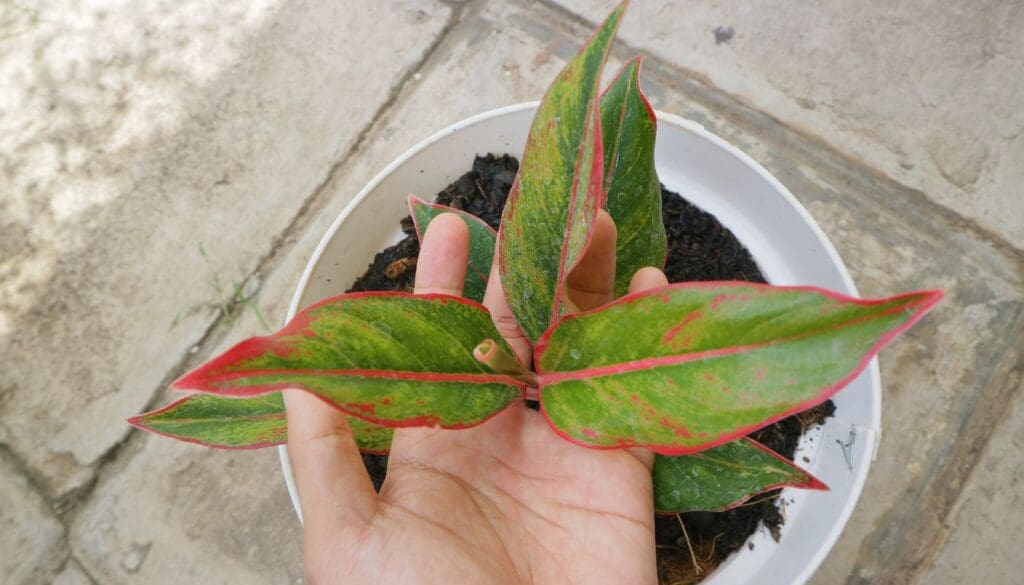5 Reasons Why Your Chinese Evergreen(Aglaonema) Is Not Growing
One of the easiest growing plants in the houseplant community is the Chinese evergreen (Aglaonema). However, it is not impossible to notice that your Chinese evergreen is not growing!
Today in this article we shall learn why is my Chinese evergreen not growing.
A Chinese evergreen will generally stop growing when it doesn’t receive the ideal growing conditions. Under and overwatering, temperature stress, fungal diseases, pest infestations, and low humidity are some common problems that can impact the growth of Chinese evergreen.
Relax and take a deep breath because, in this article, I will explain all the possible reasons that disturb the growth of your Chinese evergreen plant. I will also answer how to encourage growth in your Chinese evergreen.

Please note: Simplify Plants is reader-supported. Some links in the post are affiliate links and I get a commission from purchases made through links in the post.
What’s wrong with my Chinese evergreen?
If your Chinese evergreen is not growing, it indicates that something is wrong with the plant. Let’s discuss some possible reasons stopping your Chinese evergreen from growing.
Incorrect watering
Watering the Chinese evergreen may not seem daunting, but when to water, how much to water, all these questions can complicate it. Often beginners find it challenging to come to the proper watering routine.
Chinese evergreens enjoy moisture in the soil, but that doesn’t mean they will enjoy being wet. If you water too little and make the soil dry or water too much and make the soil soggy, it will become difficult for the Chinese evergreen.
Finding the right time and quantity of water to provide to your Chinese evergreen will help you avoid underwatering and overwatering. But before that, let’s take a look at both.
Also read: How Much Water Does A Chinese Evergreen Need? (How Often+Summer & Winter)
Underwatering
Chinese evergreens can tolerate underwatering for a while, but keeping it underwatered for too long can make it weak.
Without sufficient water supply, the plant will get dehydrated and not absorb nutrients from the soil either. Without water and nutrients, your Chinese evergreen will lack the energy to grow.
Here’s how you save an underwatered Chinese evergreen:
- Insert a stick into the soil to make small holes. This will loosen the compact soil.
- Water the soil a little and wait for it to get soaked.
- Once the water gets soaked, you can water your Chinese evergreen thoroughly.
Overwatering
Overwatering is not unusual as many people think that watering the plants more will keep them happy. However, that’s a myth.
Overwatering can cause different problems that can decline the health of your Chinese evergreen plant. If you overwater your Chinese evergreen:
- Its roots will remain wet.
- The excess water will cut off the oxygen supply into the roots.
- The roots will fail to function due to the lack of oxygen and too much water.
- They will start decaying if you don’t notice the early signs and take action.
Here’s what to do if you have overwatered your Chinese evergreen:
- If you notice still water on the pot, tilt it to get rid of the water.
- Keep the plant in a bright place to get ample indirect light to dry out the soil.
- You can take the Chinese evergreen out of the pot and spread the soil on paper to let it dry out.
- However, if you notice brown, soft roots, you must remove those and repot your Chinese evergreen in a new pot and fresh potting mix.
Also read: How Do You Save An Overwatered Chinese Evergreen? (Signs, Causes & Fix)

Temperature stress
Although a Chinese evergreen can tolerate a wide range of temperatures, it can stop growing if it doesn’t get the ideal temperatures for growth.
Use a thermometer to keep the temperatures in check and ensure it’s not too high or low for your Chinese evergreen. Instead of measuring the room’s temperature, find out the temperature around the plant.
The temperatures can go down during winter, and if you’re not careful, the plant will get stressed due to the low temperatures.
A Chinese evergreen exposed to low temperatures for too long or experiences temperature fluctuations will not grow and can even show signs of stress such as droopy leaves, discolored leaves, etc.
If your Chinese evergreen has undergone temperature stress and stopped growing due to it, you can follow these steps to revive it.
- Bring your Chinese evergreen to a spot with temperatures between 68-77°F.
- Don’t expose the plant to direct sunlight which can raise the temperatures more than the plant’s liking.
- Don’t place your Chinese evergreen near windows and doors opened and closed frequently.
- Protect your Chinese evergreen from low temperatures and frosty locations during winter.
- Keep the Chinese evergreen away from cold and hot drafts.
- Avoid exposing your Chinese evergreen to the direct air of the AC.
- Avoid placing the plant too close to heating sources like radiators, fireplaces, and heaters.
Also read: How Cold Can Chinese Evergreens Tolerate? (Chinese Evergreen Cold Tolerance)
Pest infestation
Chinese evergreens are not prone to pest infestation, but you might spot pests on them if exposed to unfavorable conditions for too long. Common pests you might find on your Chinese evergreen are aphids, mealybugs, spider mites, etc.
These pests come to your Chinese evergreen to feed on it. Pests suck the plant’s sap that contains nutrients that the plant needs. Without this, the plant will become weak.
Thus, the pests make your Chinese evergreen weak and can even kill the plant as they populate very fast. If your Chinese evergreen is not growing, you must inspect the plant and undersides of leaves, where the pests usually reside.
- If you notice any pests, consider these:
- Shower your Chinese evergreen with a strong spray to remove the pests and leave it in a bright spot.
- Handpick all the visible pests.
- Dip some cotton into alcohol and wipe the areas with pests with it.
- Spray a neem oil solution on the Chinese evergreen until all the pests disappear.
- Prune all the diseased and damaged parts of the plant if required.
Also read: Do Chinese Evergreen Get Bugs? (Common Bugs+How To Get Rid Of Them)

Fungal disease
Another severe issue that might occur in your Chinese evergreen is a fungal disease. The Chinese evergreen plant is prone to different diseases such as fungal and bacterial leaf spot disease, root rot, etc.
You might notice signs like spots on leaves, discoloration of leaves, holes in leaves, etc. As the disease spreads and increases, the plant can experience severe conditions.
You must protect your Chinese evergreen from unsuitable conditions, and if you think it is undergoing a fungal disease, you must spray the plant with a Copper fungicide solution.
If you overwater your Chinese evergreen, it will develop the fungal root rot disease, severely affecting the roots. All these conditions can inhibit the growth of your Chinese evergreen. You must not overwater your Chinese evergreen to avoid the root rot disease.
Time of the year
Like many houseplants, Chinese evergreen goes dormant during the winter season. This is because winter comes with low temperatures that are unfavorable for these plants.
So, instead of growing, they conserve energy and focus more on surviving the winter. This is why you may not see your Chinese evergreen growing during winter.
However, this is nothing to worry about as it is natural. Once the season changes, you’ll notice growth in your Chinese evergreen in the spring and summer months.
Is Chinese evergreen slow-growing?
Chinese evergreens don’t grow fast. They are moderate to slow growers as they have a shallow root system and take time to grow.
Chinese evergreens require a few years to reach maturity.
You don’t need to repot your Chinese evergreen too frequently like many of your other houseplants. You need to repot them only if they get rootbound or develop any disease.
Since Chinese evergreen is slow-growing, its roots take time to get rootbound and require repotting once 3-4 years.
Also read: How Fast Does Chinese Evergreen Grow? (+Factors Affecting Growth Rate)
How to encourage growth in Chinese evergreens?

You don’t need to do anything special to make your Chinese evergreen grow. But you need to understand the conditions that can make your Chinese evergreen grow.
With proper care, your Chinese evergreen will grow at the usual speed without being hindered by unfavorable conditions. Let’s look at the necessities of a Chinese evergreen plant.
Light: Chinese evergreens are great at tolerating low-light environments that make them ideal for office areas. But if you ask me, Chinese evergreens will do best and grow most when you provide bright indirect light to the plant.
Water: In general, Chinese evergreens require watering once in 7-10 days. But without following any schedule blindly, you must rely on the soil’s moisture level.
Check the moisture level and if the topsoil feels dry, water the plant. If not, wait for it to go dry. This will prevent underwatering and overwatering.
Soil: Chinese evergreens require a well-draining soil mix that doesn’t hold excess moisture but retains enough to keep the soil from going entirely dry.
Chinese evergreens prefer evenly moist soil, and an ideal recipe will include peat-based potting soil mixed with some perlite.
Fertilizer: Chinese evergreens don’t require heavy feeding and can do well with little fertilizer. You must feed it during the growing seasons only. Avoid fertilizing it in winter.
You can fertilize your Chinese evergreen with a balanced liquid fertilizer once every 2-3 weeks. Dilute the dose to avoid the chances of overfertilization.
Temperature: Maintaining the correct temperature for your Chinese evergreen is crucial if you want to see it growing. It’s a tropical plant, so it prefers a warm climate with temperatures between 68-77°F.
You can keep a thermometer handy to understand the temperature around your Chinese evergreen. Don’t expose the plant to low temperatures during winter as that can cause severe damage and affect the growth.
Humidity: Chinese evergreens prefer high humidity. Without enough humidity, you can’t expect growth in the plant. In its natural land, it gets humidity of 70%.
You can install a humidifier to maintain high humidity levels inside the house. If you can’t provide very high humidity levels, don’t let it go below 50%.
You can keep your Chinese evergreen together with other houseplants or take it to the bathroom or kitchen to provide more humidity if you don’t have a humidifier.
Repotting: As mentioned earlier, Chinese evergreens have shallow roots and don’t require frequent repotting. Repotting them too often can stress them out.
Usually, a Chinese evergreen will require repotting once in 3-4 years when it gets rootbound. Don’t let the Chinese evergreen remain rootbound for too long, as that can stop the plant’s growth.
Pruning: You can’t encourage growth in your Chinese evergreen by pruning it. However, if you notice any dead or damaged leaves and stems, consider pruning them off.
You can also prune the blooms that you might notice in your Chinese evergreen during summer. Pruning these can encourage more foliage growth.
Extra care tips:
- Mist a neem oil solution on your Chinese evergreen once a month to keep pests away.
- Rotate the Chinese evergreen plant regularly to provide light on all sides.
- Keep the Chinese evergreen away from spots with direct sunlight.
- Clean the leaves of your Chinese evergreen to encourage more photosynthesis.
- Keep the Chinese evergreen away from pets and children to protect both parties.
- Use artificial light if the plant is not getting enough natural light.
- Don’t place the Chinese evergreen outside during winter.

Reference: Wikipedia, Nasa clean air study, Missouri Botanical Garden, The University of Kansas, NC State University.
Recommended Garden Supplies
| Product Image | Our Recommended Gardening Supplies | Check Offers! |
|---|---|---|
Top Top
Top
Top
Top
Top
Top
Top
Top | rePotme Houseplant and Tropical Classic Potting Soil Mix | Check Offer On Amazon |
 Top
Top
Top
Top
Top
Top
Top
Top | Espoma Organic Indoor Plant Food | Check Offer On Amazon |
 Top
Top
Top
Top
Top
Top
Top
Top | GooingTop LED Grow Light 6000K Full Spectrum Clip Plant Growing Lamp | Check Offer On Amazon |
 Top
Top
Top
Top
Top
Top
Top
Top | Soil Moisture Meter | Check Offer On Amazon |
 Top
Top
Top
Top
Top
Top
Top
Top | Govee Hygrometer Thermometer, Bluetooth Enabled! | Check Offer On Amazon |
 Top
Top | LEVOIT Humidifiers for Large Room(Best For Plants) | Check Offer On Amazon |
 Top
Top
Top
Top
Top
Top
Top
Top | Upgraded DIY Automatic Drip Irrigation Kit, 15 Potted Houseplants Support | Check Offer On Amazon |
 Top
Top
Top
Top
Top
Top
Top
Top | Stainless Steel Heavy Duty Gardening Tool Set | Check Offer On Amazon |
 Top
Top
Top
Top
Top
Top
Top
Top | Bonide Insecticidal Soap | Check Offer On Amazon |
 Top
Top
Top
Top
Top
Top
Top
Top | Bonide 32 oz Spray Neem Oil for Organic Gardening | Check Offer On Amazon |
 Top
Top
Top
Top
Top
Top
Top
Top | Garden Safe Fungicide | Check Offer On Amazon |






